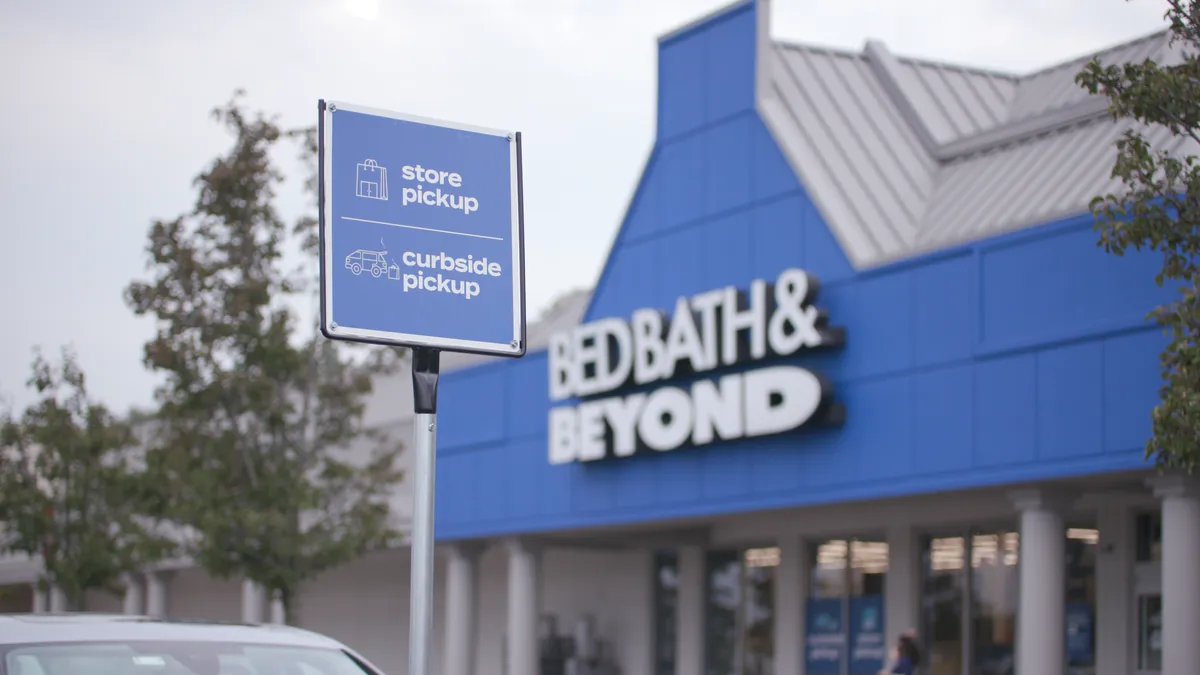Bed Bath & Beyond has a new head of all things inventory and not a moment too soon.
The retailer is setting a course to invest $250 million in its supply chain over the next three years. The sum is at least one-quarter of $1 billion to $1.5 billion in spending intended to bring about the retailer's complete transformation encompassing supply chain, IT and store fleet and operations.
John Welling, Bed Bath & Beyond's new senior vice president of merchandise planning, allocation and operations comes from J.C. Penney by way of Michaels and Walmart, where he held inventory management and operations roles. At Bed Bath & Beyond, he'll report to Chief Merchandising Officer Joe Hartsig and have both hands in the coming overhaul.
At this year's Investor Day presentation, Bed Bath & Beyond executives shared their plan to resuscitate the organization, which had been losing market share while laden with inventory and drowning in discounts. CEO Mark Tritton, who joined the brand one year ago, said small changes can make a big difference in the business.
"There's a lot of low-hanging fruit and fruit on the ground," the CEO said. Cleaning up inventory management, changing the nature of supplier relationships and integrating an omnichannel mindset is some of the low-hanging fruit, but with an extensive tech upgrade yet to come — success will be contingent on careful execution.
Rethinking inventory management
A decentralized approach to merchandising led Bed Bath & Beyond stores to over order and stack inventory from floor to ceiling. COO John Hartmann — with the company for just six months at the time of the Investor Day — called pictures shown to investors at the presentation "painful." And the overstocked stores led to high markdowns.
To correct this, the company centralized ordering and replenishment and brought in a digital forecasting tool. Faster replenishment should disincentive overstocking stores while reducing stockouts on the best-selling items, said Hartmann.
"Our average domestic replenishment time to stores has been a painfully slow 35 days," he said. "Our domestic operations are anchored largely on a cross dock model, without distribution centers, which is heavily impacted by vendor lead times."
"There's a lot of low-hanging fruit and fruit on the ground."

Mark Tritton
CEO, Bed Bath & Beyond
The approach to centralize replenishment is part of a plan the retailer laid out last year to reduce total inventory by $1 billion.
"We believe this aggressive disposition of inventory will enable us to more quickly reset inventory levels in both our Bed Bath & Beyond stores and distribution centers to allow for a faster refresh of our assortment," said then-interim CEO Mary Winston, who took the wheel after former CEO Steven Temares was asked to resign by the company's board in May 2019 and before Tritton came on board.
The company is moving to a model with centralized distribution centers, which will decrease replenishment timetables and reduce touches per order, Hartmann said. Much of the $250 million supply chain expenditure will go toward four new distribution centers.
The retailer expects to improve inventory turnover by three and a half times in three years.
Getting rid of an outdated sourcing model
In the case of Bed Bath & Beyond, bloated stores correlate with a bloated supplier network. The chain reduced its total number of suppliers by half this year, with more cuts to come.
At the heart of the problem is an indirect sourcing model in which Bed Bath & Beyond's margin was absorbed by medial players throughout the many tiers, Winston described last year. This model made it difficult for the chain to compete on price and lessened the margin benefit retailers usually expect from private label products.
The company’s product assortment was "outdated" in the words of Hartsig. Bed Bath & Beyond is decreasing its supplier base to reduce assortment complexity and to work more closely with suppliers to directly negotiate savings.
Negotiating with 60 of its remaining suppliers after the initial cull drove $100 million in savings for the company so far, said Hartsig. Over the next three years, the company will address suppliers in two more tranches, adding savings of $100 million to $150 million.
Investing in omnichannel
Bed Bath & Beyond had to get on board quickly with omnichannel, like many retailers that hadn’t adapted to the trend before the pandemic.
The retailer launched buy online, pickup in store and curbside pickup in more than 1,000 stores in May. It added same-day delivery to its offering through partnerships with Shipt and Instacart.
It is also shipping e-commerce orders from 40% of its stores in the U.S. and Canada, which optimizes fulfillment cost and speed, Chief Digital Officer Rafeh Masood said.
The reviews from analysts have been largely positive.
"Outstanding performance" with "much more to come" was the review of Wedbush analysts after Bed Bath & Beyond's first quarter with BOPIS.
UBS analysts said the management team "clearly understands what factors have caused its P&L to regress over the years and is moving quickly to address several of its shortcomings." The analysts also agreed with Tritton's assessment of the low point from which the about-face is starting — calling the retailer's supply chain "primitive."
"There are significant execution risks associated with such a massive undertaking."

UBS Analysts
Bed Bath & Beyond needs a lot of work to bring its supply chain on par with competitors like Walmart and Target — let alone digital-first rivals like Amazon and Wayfair.
CFO Gustavo Arnal said the company must "focus on cost savings and sourcing savings, while at the same time embracing the growth of digital and further optimizing our cost of fulfillment, the different routes shipping directly to customers."
There may be plenty of low-hanging fruit, and even fruit on the ground, but the challenge will be picking it all at the same time.
"There are significant execution risks associated with such a massive undertaking. Plus, the success of the plan ultimately hinges on the external environment remaining supportive," UBS analysts wrote.





















